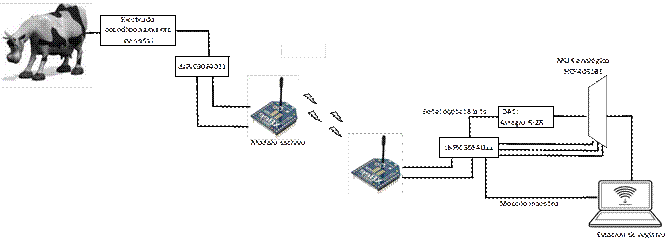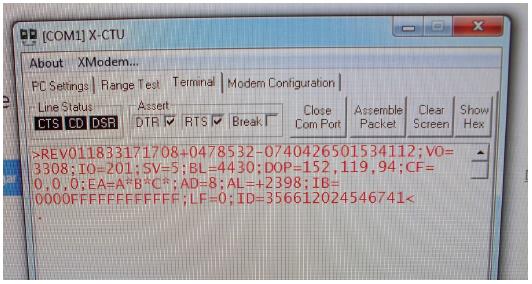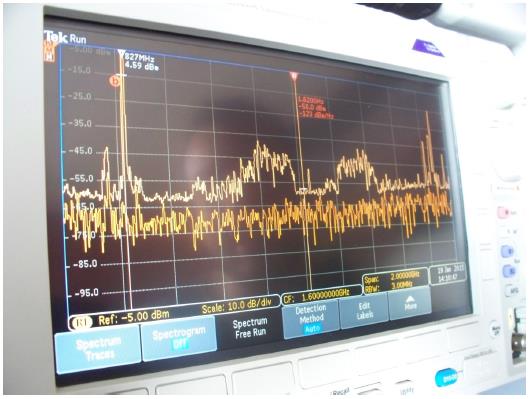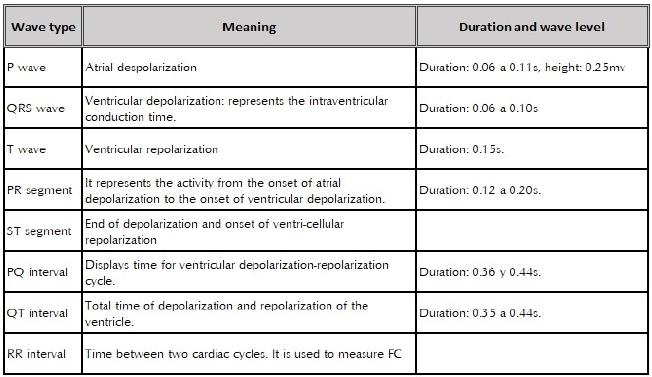INTRODUCTION
The welfare of a society depends on the quantity and quality of the meat cosumed by its members (Joo, et al., 2013). This quality of meat depends, in turn, on the health, age, weight, and well-being prior to slaughtering of livestock (Onenc, 2010; Grandin, 1980). However, inadequate cattle management methods in Colombia, before slaughter, affect the physical and psychological state of the individual (Romero, et al., 2017). An animal responds to changes in its well-being in multiple ways, including a range of physiological responses.
The hypothesis of the study was: "One might think that a high sampling rate in the conversion of an analog signal into digital data and wireless transmission could benefit the reception of a bovine heart signal reliably and from anywhere". In this perspective, the research consisted of designing and constructing a radio telemetry system that allows non-intrusive monitoring of the heart rhythm of the cattle to determine the presence of physiological indicators of stress before slaughter. The study aimed to validate a radio telemetry equipment, which measures physiological constants, one of the many indicators of stress (Stockman, et al., 2011); in addition, could be used to monitor the health of horses or other animal species.
MATERIALS AND METHODS
The design of the radio telemetry system comprising the steps shown in fig. 1, is intended to monitor the cardiac signal in a non-intrusive manner; which is implemented on a strap with a suction cup placed around the chest of the cattle, after shave of the area (region located between the Intercostal space III and IV below the encounter line) limited by a short fixation period (up to 20 minutes).
From the sensor located on the suction cup, the animal X (t) cardiac signal is obtained. This signal is conditioned by an amplification stage (AD6209) and filtered (LF353). At this stage, the implementation of a band reject filter is also considered, which suppresses undesirable noise signals and disturbances caused by the 60 Hz power grid. The R (t) signal obtained is converted to digital and modulated / demodulated into XBEE transceiver modules. The signal Y (t) is processed in a portable computer, to subsequently display the information of interest in a graphical interface. The block diagram of the unidirectional telemetry radio system can be seen in figure 2.
The XBEE PRO®XSC modules were used as virtual transmitter and dual receiver in virtual cable mode; its technical specifications can be found in Digi International Inc. (2009). As shown in figure 3, the XBEE transmitter and receiver were programmed with the help of the X-CTU software. The XBEEs were configured for transparent serial transmission (AT mode).
The electrode detects the cattle cardiac signal and passes it to electrical signal. The conditioning circuit amplifies the voltage and filters it, before sending it to dsPIC30F4011 that processes it (sampling rate of four million samples per second). The XBEE modulates baseband information on an 827MHz digital carrier and transmits it with a power of 4.59dBm (figure 4).
To display the cattle record in the graphical interface, the logic of figure 5 is followed: first, the program is started and the application is selected.
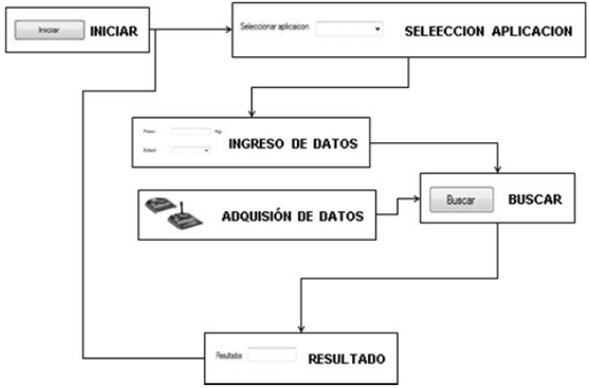
Source: The author.
Figure 5 Logic that follows in the query of the graphical interface when a record is taken and transmitted.
There are two options: stress indicators in cattle and health in horses; the latter application is not yet developed and it escapes the objectives of this work. Then enter the data of the animal: type (bovine, equine), age and weight. Subsequently a base is consulted and the results are obtained.
Although the objective measurement of bovine stress, produced by the challenges it faces in pre-slaughter activities, is a complex process, because it combines physiological, productive and ethological indicators. In this research was evaluated from the response of some physiological constants of the animal. To achieve this, the physiological constants of the five specimens are monitored in two moments: i) in the production farm before being taken to the truck that will transport them to Bogotá and ii) on arrival at the slaughterhouse (just after being transported).
Physiological constants were taken directly from cattle using a stethoscope (Littmann ® classic II S.E.) - prior to the shipment of cattle in Acacias-Meta, and after landing in Bogotá, through the system of radio telemetry (February 20, 2012). Although this may have altered the animals, the same equipment was not used for protocol reasons. The identification of the values of the physiological constants in Bogotá was done indirectly through correlation with the characteristics that presented the cardiac signal of the cattle.
The electrocardiogram provides information on the heart rate, rhythm and intracardiac conduction system of the cattle; however, a correlation factor can be inferred with the respiratory rate and body temperature presented by the cattle just after being transported. To determine these factors, we first identify the types of waves that make up the cardiac signal, with their electrical potential amplitude (mV) and duration (s) characteristics. Figure 6 shows the wave types and in table 1 their characteristics.
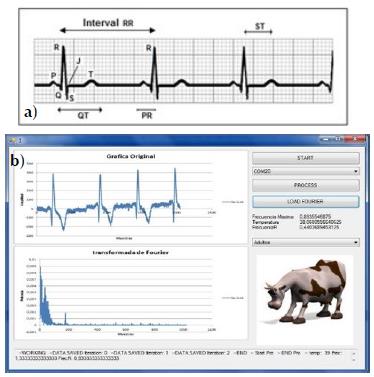
Note: J is the point at which the S wave ends and the ST segment begins. Frequency is the number of pulsed waves detected per unit time. Source: The author.
Figure 6 a) Wave types of bovine cardiac signal (Valderas, et al., 2015). b) Cardiac signal represented in the time and frequency domains, and captured by proprietary graphical interface.
In order to identify the heart rate of an animal from its electrocardiogram, the time of a beat is first obtained (it comprises systole and diastole) (Battaglia and Mayrose, 1989): the distance in mm of the RR interval is measured and multiplied by the time spent. With the previous data applies the rule of three to get the number of beats in a minute or 60s. The inference of the cardiac rate of cattle - object of study - was done in this way and through processing of the received cardiac signal for each of the five tests for five animals (one test per animal).
The correlation factor extracted for the respiratory rate of the cattle from its cardiac signal was raised based on the consideration of Valderás, et al. (2015): According to them, ECG-derived breathing (RDE) can be obtained from variations in breath-induced R-peak amplitudes. To find this correlation coefficient, we take the series of intervals RR(t) not equidistant to be transformed by cubic spline interpolation to an equidistant time series with a sampling frequency of 10Hz. The RR components (t) were obtained using two FIR filters, one high pass with a cutoff frequency of 0.2 Hz, and one low pass with a cutoff frequency of 0.4 Hz. The frequency band between 0.2 and 0.4 Hz, because the most important components of cattle respiration are in that range.
The increase in the body temperature of the cattle due to pre-slaughter handling triggers the consumption of oxygen by the tachycardia and the high cardiac output. The internal mechanisms by which cattle lose heat are sweating, vasodilation and respiration. When the temperature of the cattle is low, it is produced vasoconstriction, involuntary muscle contractions, which increase the muscle tone or basal contraction of the muscles, and if it is more intense produces a perceptible tremor. The information on the inferred physiological counts of the cardiac signal taken on five occasions followed the algorithm based on the RDE in the orthogonal derivation ECGx (Valderas, et al., 2015). Table 2 shows the correlation coefficient of the cardiac, respiratory and body temperature rates extracted from the ECG.
Table 2 Specifications of tests and findings
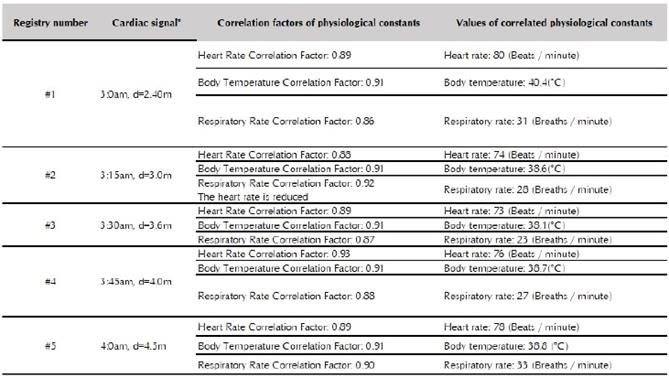
* represented in the time and frequency domains, and captured by proprietary graphical interface.
Source: Compiled by the author
The statistical analysis of the data collected in the five tests has been made the chi-square test, the comparison of means test for related samples and the Pearson r correlation, estimating a statistical significance "p" less than 0.05. In addition, the results show an average quality of communications in real time is 76.3% of the total of transmitted events (achievement of data packets transmitted).
Results
Physiological constants taken directly from bovine using veterinary medicine instruments - prior to shipment were heart rate = 66.3 ± 9 (beats / minute), respiratory rate = 13.2 ± 10 (breaths / minute) and body temperature = 38.9 ± 0.25 (in °C). These values with their standard deviations of cattle examined are within the ranges considered normal according to McGovern and Bruce (2000).
The mean percentage relative error was less than 2.0% for an average positive Pearson correlation coefficient of 0.91. Obtaining the values of the physiological constants the difference of the same ones was extracted in two moments on farm, before the transport, and just after being transported. Table 3 shows the differences.
Table 3 Values of physiological constants for adult cattle (40 months) with an average weight of 414 kilos
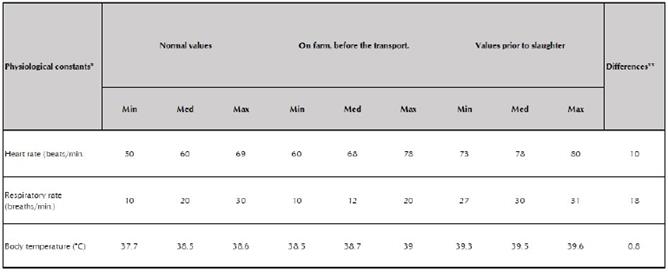
Note:
* Values of the mean physiological constants inferred from the cardiac signal in the five records for adult bovine of the race san Martinero
** Differences between pre-dressing versus pre-slaughter mean values.
Min: mínima, Med: media, Max: máxima
Source: The author
By concentrating the data (table 2), calculating the standard deviation, and evaluating the difference between on farm, previous to the transport, and just after being transported records (last column of table 3), the difference in body temperature in cattle is very low (0.6 ± 0.2). Otherwise, it occurs with cardiac rate (10 ± 2.25) and respiratory rate (15 ± 4) which show higher oscillations in relation to normal reference values.
Discussion of results
There were found that physiological constants of some cattle to be outside the ranges considered normal by the authors: temperature according to Battaglia (1989); heart rate, respiratory rate and pulse according to Ávila, et al. (2008). It was not validated if there was synchronism between arterial pulsations and heart rate of the animal, now that the measurements were taken in the five tests; it is possible that there was not, in that case the heart rate of the cattle, and the values of the physiological constants could be altered.
In the cattle monitored signal a sinus bradycardia is evidenced: frequency below the limits marked as normal for the race, weight and age; Increased inspiratory effort possibly due to hypothermia and hypoglycemia.
In this perspective, it can be affirmed that the cardiovascular system plays an important role in producing circulatory adjustments (vasodilatation-heat or cold vasoconstriction) according to the thermoregulatory need of the body (hypothalamic level). In conditions of hypothermia and agitation, such as that presented in a period of time prior to sacrifice, the cardiorespiratory frequency oscillates in an unstable and critical way. Likewise, a direct relationship between heart rate and respiratory rate is evidenced: increased heart rate leads to increased respiratory rate, more CO2 is eliminated, which could lead to cattle alkalosis.
The correlation between the cardiovascular and respiratory systems is evidenced in the interaction caused by spontaneous breathing, which produces variable oscillations in the evolution of heart rate and blood pressure variability, synchronized with respiratory rate (Porta, et al., 2015; Schulz, et al., 2013).
According to McGovern and Bruce (2000), the cattle cardiovascular system undergoes important changes to gain / release heat from the medium / body. The animal acute stress response due to pre-slaughter handling results in an increase in cardiac output, cutaneous vasodilation and tachycardia mediated by hypothalamic reflexes of the central nervous system (Schumm, et al., 2015). These changes are evidenced in a prolonged QT interval (which normalizes after cooling) and diffuse alterations of the ST-T segment (Knowles and Warriss, 2006). Consequently, a time-frequency analysis of the cardiac signal variability under non-stationary conditions is performed to obtain the cattle body temperature correlation factor. First the prolonged QT time series of the electrocardiogram signal is identified to evaluate by delta Fourier series of length; In addition, new spectral components in the ST series (t) are identified by FIR filtering.
Faced with a stressful stimulus, there is usually a change in the heart rate expressed in tachycardia in cattle as a consequence of animal manipulation (Sanchez, et al., 2007). This change induces an increase rate because the animal prepares to respond actively.
The body temperature of the cattle is obtained from the balance between the heat produced and the eliminated heat, however, there is little heat produced due to the fasting condition of the animal, and to the null intake of salt and water. Consequently, the animal consumes its reserves, while the loss of heat continues to increase because the hypothalamic center is not capable of inducing the corrections required by the thermal variations. In this context, the increase in respiration increases heat loss through the airways and is one of the most important ways to maintain the thermal balance.
Under normal conditions, the body temperature of the cattle is not a constant, there is the influence of the circadian rhythm with peak temperature between 18 and 22 hours of the day, being minimal between 2 and 4 of the dawn, there are also differences between different points of the body and in some physiological states, such as stress (Mounier, et al., 2006).
The heat gain of the animal's body depends mainly on the muscular activity. Keeping the posture standing determines a muscle activity that increases thermogenesis. Thermoneutrality is another condition because temperatures above or below the thermal comfort range of the species decide modifying responses of energy metabolism. Loss of temperature via excretion (feces and urine) and gasping (the evaporation of heat by the respiratory tract rises).
The response to stress is very variable and dependent on the individual capacity, which varies according to the breed and physiological state of each animal; if the stressor acts for a long time (transport and prolonged fasting), the effect will be higher. Therefore, the longer the transport and fasting times, the greater the probability of presenting stress, negatively affecting the welfare of the animals, increasing the weight losses of the carcass, greater presence of negative effects on the quality of the meat, the appearance of dark cut, which is characterized by the presentation of meats of hard consistency, dark red color and dry appearance.
To reduce the acute stress experienced by cattle before slaughter, there are preventive methods such as the administration of sugars during long waiting periods before slaughter (Davis, 2001). The possible mechanism would be a prevention of glycogen drop or a re-synthesis. Since cattle are herd animals, another strategy that is recommended is to make pre-slaughter maneuvers in groups. Similarly, cattle supplements such as tryptophan are usually administered to reduce the presence of PSE meat associated with pre-sacrificial stress (Barreras-Serrano, et al., 2008); although this condition is more common in pigs than in bovine.
It is also suggested to habituate the animals to the management procedure, eliminating any environmental novelty and keeping the presence of companions of corral if possible. In any case, it is always likely that there remains an individual variability of genetic origin that to date has not been evaluated.
Assuming that the solution and the plan proposed in the directed project was a prototype radio telemetry system, and not to an already standardized radio solution, the following problems that were presented in the communication are understandable: data loss in point-to-point transmission point. Likewise, recording information was lost at reception due to the low sampling rate and the clock frequency limitation for flow control. To minimize this problem, you must over-sample or create an automatic retransmission protocol.
With the accomplishment of this work, a greater knowledge related to the taking and determination of the physiological constants is reached.
Conclusions
Reliable information was transmitted, taking advantage of wireless communications (easy installation, possibility of transmitting information to any point within the network coverage, saving space and money by requiring less hardware, mobility of the terminals, etc.). However, as mentioned by Berezdivin, et al., (2002), such radio communications also show limitations such as range, low data transmission rate and noise and interference errors.
It was checked that the cinch and the information capture circuits did not affect the measurement, that in the transmission there were no delays or data loss, and that the ordered reception of information packets allowed the correct recovery of the bovine heart signal. However, during the tests, at least two people are required to carry out the test, one in constant supervision of the behavior of the bovine, and another in the operation of the system: capture, interface, transmission and reception of data.
As a final conclusion, it is establishes that the research in wireless monitoring and telemetry systems is a line of great interest for the non-intrusive measurement of the cardiac signal of a bovine, which is subject to stress before its sacrifice. In addition, it could be applied for equine health supervision or other type of animal management that involves remote monitoring of vital signs.














